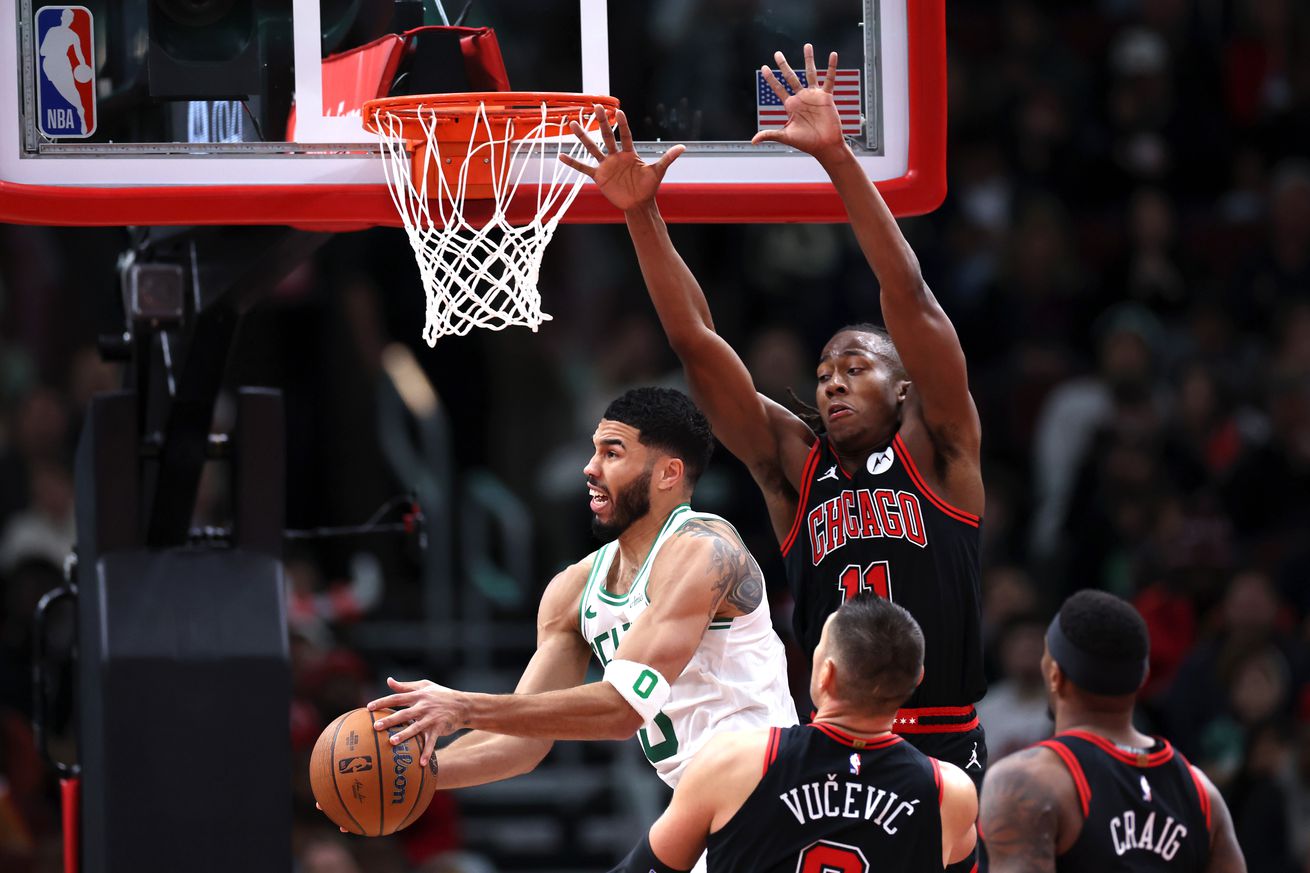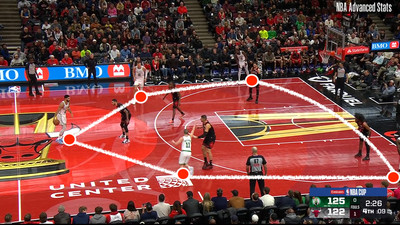
The Boston Celtics matched Chicago’s pace, showcased scoring efficiency, and exposed both strengths and vulnerabilities in a high-scoring NBA Cup showdown.
#1 – The Boston Celtics tried to match the Chicago Bulls’ pace
So far this season, the Bulls are the fastest team in the NBA. After a made basket by their opponents, Bulls’ possessions last 15.5 seconds on average, compared to the league average of 17.3 seconds and the Celtics’ 17.9 seconds. Against the reigning NBA champions, Billy Donovan’s team knew they needed to push the pace even harder—and they did.
After Celtics’ made shots, the Bulls averaged 14.6 seconds per possession. They aimed to disrupt Boston’s defense by running more and preventing the Celtics from setting up their usual schemes. The Bulls’ 129 points suggest this strategy worked. However, the Celtics also accelerated their tempo.
Joe Mazzulla’s team mirrored the Bulls’ approach, shortening their possessions by an average of 1.5 seconds after made baskets. By matching the Bulls’ pace while leveraging their superior talent, the Celtics scored 139 points—their second-highest output this season.
While the Bulls use speed to compensate for a lack of talent, the Celtics adapted and proved their versatility, ultimately prevailing with their superior skill and adaptability.
#2 – Jayson Tatum’s efficiency masterclass
With only 18 field goal attempts, Jayson Tatum scored 35 points. He took just one mid-range shot, focusing instead on threes and shots at the rim. The Bulls had no answers. Their lack of rim protection was evident on this drive: Tatum posted up Lonzo Ball, drove to the rim, and Vucevic barely contested him.
The Bulls’ defense struggled even more when they went small, leaving Josh Giddey to guard Tatum. Tatum’s finishing at the rim, now at 79% this season, continues to improve. On this play, he remained calm, composed, and collected, demonstrating why his efficiency has reached new heights. His jumper also looks as sharp as ever.
Whether the Bulls dropped or switched on pick-and-rolls, Tatum’s lethal pull-ups made life impossible for their defense.
They simply had no answer for his scoring brilliance.
#3 – Better spacing opens up the rim
The Celtics attempted 30 shots at the rim last night, converting 74%—a rare occurrence for this team. Kristaps Porziņģis played a significant role in creating this dynamic.

By positioning Jrue Holiday and Jaylen Brown in the corners against weaker defenders like Zach LaVine and Coby White, the Celtics limited the Bulls’ defensive rotations. This also forced Nikola Vucevic into actions he wasn’t comfortable with.
The Celtics’ use of screens and switches put the Bulls in lose-lose situations. When the Bulls adjusted to contest threes, Boston shifted to attacking the rim, showcasing their ability to adapt.
#4 – Payton Pritchard’s unconscious fourth-quarter run
In just five minutes, Payton Pritchard scored 19 points—a performance for the ages. The variety in his scoring actions was remarkable.
After hitting a spot-up three, he set a ghost screen for Jaylen Brown, freezing the Bulls’ defense and creating another open three.
Next, he drove past Josh Giddey, using perfectly timed steps to avoid the defense and finish at the rim with composure.
He also delivered highlight plays, like this step-back jumper after nearly losing his balance:
Pritchard finished with 29 points in 28 minutes, adding four offensive rebounds and excellent playmaking—a strong case for Sixth Man of the Year.
#5 – Kristaps Porziņģis’ mobility Is key
Coming off a long injury, Porziņģis’ mobility was in question. Last night, he proved doubters wrong by sprinting into early screens and playing with noticeable speed and fluidity.
In one sequence, he sprinted to set a screen for Derrick White, forcing Vucevic into action. Then, he faked a dribble handoff and freed Lonzo Ball under the rim.
His agility also created opportunities for himself. On another play, he used a ghost screen to gain separation, then attacked the rim like a guard driving against a close-out.
Porziņģis’ speed and decision-making were encouraging signs for his comeback.
#6 – Post-up dominance from Kristaps Porziņģis
The Celtics returned to their high-post actions, using Porziņģis to exploit mismatches against smaller guards. Even tall defenders like Josh Giddey looked helpless against KP’s size and patience.
Porziņģis displayed excellent composure, using fakes and power dribbles to score or draw fouls. He finished with three field goals and seven free throws from post-up plays, adding another dimension to Boston’s elite offense.
#7 – Late adjustments by the Bulls
After a long night of switching on every Celtics screen, the Bulls finally started sending two players on the ball handler to force the ball to move. After a solid game at taking care of the ball, the Celtics lose the ball three times in the last three minutes of the game.
Nonetheless, after a couple of bad offensive possessions, the Celtics adjusted to make sure the Bulls had no choice but to switch Vucevic on the ball. They multiplied the screens to make sure the big man was moving and involved in the action and ran as fast as possible in transition. This cut short the Bulls expectations of a comeback.
#8 – Nikola Vucevic’s game showed why the Celtics’ defense can be beaten
The Montenegrin big man is the archetype of a player who can disrupt the Celtics’ defensive scheme with two key skills: shooting and post-up scoring.
Often, the Celtics assign Jayson Tatum to guard the opponent’s center and let Porziņģis roam as a help defender against the weakest shooter. This approach worked well in last year’s NBA Finals because Daniel Gafford, for example, couldn’t exploit Tatum with post-ups.
However, Vucevic is a different challenge. He can attack Tatum in the post or take advantage of any switch to punish smaller defenders after screens. The Celtics can’t simply assign Porziņģis to guard him either, as Vucevic’s shooting would drag Porziņģis away from the paint, leaving Boston’s rim protection exposed.
Vucevic’s versatility created problems for the Celtics throughout the game, highlighting a recurring issue in their defensive setup. As Marc Campbell noted last year, a shooting big man with post-up ability might be the only type of player who can truly dismantle Boston’s otherwise elite defense.
#9 – Jaylen Brown: the best in-game dunker
Jaylen Brown’s ability to throw down posters is unmatched. Let’s not take his spectacular in-game dunks for granted.
Jaylen Brown, the game’s best in-game dunker, just dunked in the game pic.twitter.com/IdzysYwYYP
— Basketball Poetry (@bballispoetry) November 30, 2024
#10 – Celtics’ NBA Cup hopes stay alive
Despite the Hawks’ win over the Cavaliers, the Celtics still have a path to advance in the NBA Cup. Per Khari A. Thompson, here are the scenarios:
“The Knicks blow out the Magic by 37 or more and Bucks beat Pistons by 5 or more. Orlando (+60) has a sizable advantage over the Celtics (+23) in point differential that can only be overcome if New York beats Orlando by 37 or more. If the Knicks beat the Magic by that much or more, the Celtics would have the tiebreaker over Orlando. The Pistons (+28) differential would fall below the Celtics’ (+23) differential if Detroit loses to Milwaukee by 6 or more.
The Knicks blow out the Magic by 37 or more and Pistons beat Bucks (+29) by 7 or more. Same scenario as above, except Milwaukee would be tied with Boston and would their point differential would drop below +23 with a 7 point loss or more.
Magic win, Pistons beat Bucks by 7 or more. The Knicks (+15) would be tied with the Celtics at 3-1, and since their differential is already smaller than the Celtics, any Knicks loss would give the Celtics the tiebreaker over them no matter the score.
Magic win, Bucks beat Pistons by 6 or more. Celtics would get point differential tiebreaker over these teams as explained above.”